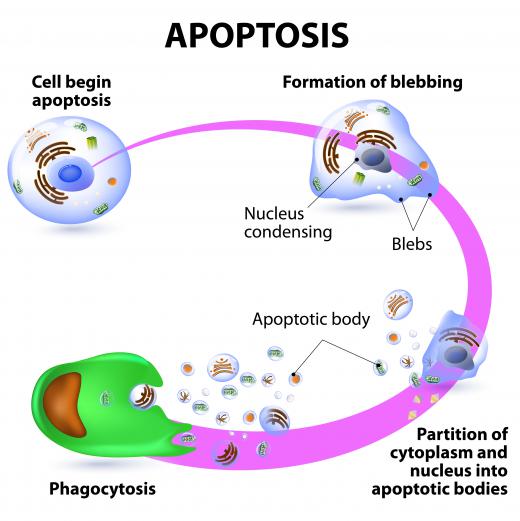What Is Cell Cycle Arrest?
 Mary McMahon
Mary McMahon
Cell cycle arrest is a stopping point in the cell cycle, where it is no longer involved in the processes surrounding duplication and division. The natural cell cycle includes a number of checkpoints that allow the cell to determine whether to proceed with division or stop. These halts can also be induced by external factors like exposure to radiation or medications used to control cell growth. Research on cell cycle arrest provides important information about how cells regulate themselves and what happens when these processes go wrong.
The phases of the cell cycle start with G1, when a cell gets ready to duplicate itself. During the S phase, it actively copies its genetic material, called deoxyribonucleic acid (DNA), and in G2, it has an opportunity to repair damage before M, mitosis. After mitosis, the cells can enter G1 again, or go into G0, where they rest. At each of these phases, a checkpoint temporarily halts the cell cycle to allow the cell to decide if it should continue. Some cells are programmed to duplicate infrequently, while damaged cells may need time for repair or destruction.

Sometimes, cell cycle arrest proceeds apoptosis, cell death. This occurs when a cell senses that it is no longer functional because of DNA damage. The cell targets itself for destruction and shuts down, allowing the body to clean up the detritus and reuse it in the production of other cells. Cell cycle arrest allows cells to maintain their integrity by stopping to check themselves periodically for signs of DNA destruction that might cause functional problems or lead to the development of a tumor. It is not always a perfect process, as demonstrated by the development of cancerous growths.
Medications may be able to introduce this stopping point, either by accident or as part of their therapeutic properties. Cells in culture may respond to these medications by stopping division processes, illustrating that something in the drug is causing cells to hit a checkpoint and stay there. These medications can be used for activities like cancer therapy, where the goal may be to prevent the continued replication of tumor cells to limit the growth of a cancer. In other cases, the temporary stop is an accidental and unintended side effect.
Environmental factors can also play a role in cell cycle arrest. Some single-celled organisms have the ability to enter a state of suspended animation in response to adverse conditions, reviving when the environment is more friendly. Specific multi-cellular organisms are also capable of this in some conditions. Exposure to high levels of radiation or chemicals may also trigger cell cycle arrest in some organisms.
AS FEATURED ON:
AS FEATURED ON:











Discussion Comments
This article helped my understanding of the cell cycle a lot! Thank you.
Finding drugs that can control this activity could be the next big thing. Some would call it a cure akin to penicillin.
It's hard to hack into the human body and get it to do what you would like it to do. The human body is a very complex system and DNA is incredibly difficult to sort through.
Someday we may be able to take a pill and regrow a limb or maybe a new liver. Today we can only do what our technology lets us.
Post your comments